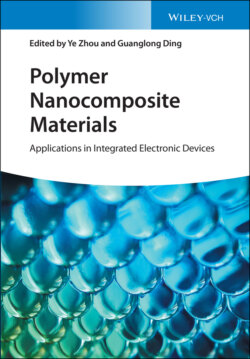Читать книгу Polymer Nanocomposite Materials - Группа авторов - Страница 13
1.2 The Advantage of Nanocomposites
ОглавлениеSince the fillers of nanocomposites are nanoscale, the performances of nanocomposites can be improved by the advantages of the reduction of filler size and the increased surface area. In terms of size, the filler is 3 orders of magnitude smaller than the traditional substitute. In addition, the quantum confinement effects caused by the nanomaterials will lead to new physical phenomena, which can be applied in electrical and optical research. Many of these properties are related to the size of the polymer chain, and the polymer chain close to the fillers is affected by the interaction between the packing surface and the polymer matrix, which is different from the polymer chain far away from the interface. The size of polymer chain can be reflected the radius of gyration Rg, and the thickness of the interface regions (t) around the particle is independent of the particle size. Therefore, the volume of interface material (Vinterface) relative to the volume of particle (Vparticle) will increase with the decrease of particle size.
Figure 1.3 shows the functional relationship between the Vinterface/Vparticle varies and the aspect ratio of particles [13]. The aspect ratio reflects the shape of the particles, which can be divided to plate (aspect ratio <1), sphere (aspect ratio = 1), and rod (aspect ratio >1). δ represents the size of the filler, that is, the ratio of the interface thickness t to the minimum dimension size of the particle. For spherical and rod-shaped particles, δ is equal to the t/r, but δ is 2t/h in plate-shaped particles. When the particle is microscale, δ is approximately equal to 0.01, and the particle volume exceeds the volume of the interface region in all shapes. As the particle size decreases, Vinterface/Vparticle values gradually increases. When δ goes above one, Vinterface is going to exceed Vparticle. When the particles reach the nanoscale (δ = 10), the interface volume is more than 10 times that of the particle. Moreover, particles with different shapes have different Vinterface/Vparticle in the same δ. The three-dimension sphere has the highest value, followed by the two-dimensional rod and the one-dimensional plate. With the decrease of particle size, the gap becomes more obvious, and even the Vinterface/Vparticle of spherical particles is 2 orders of magnitude larger than that of plate-shaped particles. Therefore, the addition of nanoscale fillers has a great impact on the performance of polymer in PNCs. Even if the volume fraction of fillers is very small, the resulting interface region volume will be very large.
Figure 1.3 The graph on the left shows the function relationship between the ratio of interfacial volume to the particle volume (Vinterface/Vparticle) and the particle aspect ratio. The red shell represents the interface of particle, where the blue nucleus represents the particle. The graph on the right defines the particle aspect ratio and the ratio of the interfacial thickness to the particle size (δ) with different shapes (r is radius, I is length, h is height). The interface thickness (t) is considered to be independent of particle size. When the particle size is reduced to less than 100 nm, the physical properties can be controlled by the volume of the interface around the particle, which is especially obvious for the sphere and rod.
Source: Winey and Vaia [13].
As the interaction between polymer and particle is strengthened in PNCs, the interparticle interface and coordination will be reflected in the macroscopic properties. Due to the nanoscale of particles, the secondary forming constituents have a very high aspect ratio of over 100. When the volume fraction is 1–5%, these fillers can reach the percolation thresholds, which refer to the critical value of the volume fraction of the packed particles that can mutate a certain physical property of the composite material system. Therefore, the mechanical and transport performances of PNCs can be greatly improved under the condition of low load nanoparticles. Especially for the conductive particles, when the volume fraction of these particles increases to a certain critical value in polymer, conductivity of the polymer suddenly increases sharply from insulator to conductor, and the change range is up to 10 orders of magnitude.
